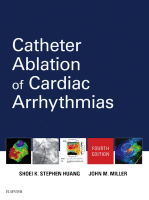Physical Address
304 North Cardinal St.
Dorchester Center, MA 02124

Key Points Anatomy Atrial tachycardia (AT) foci exhibit a characteristic anatomic distribution in both atria. The right atrium is the most common location with two-thirds of right sided focal AT arising from the crista terminalis. Pathophysiology Focal AT may be…

Key Points Cardiac imaging plays an essential role in contemporary invasive electrophysiologic mapping and ablation procedures, from guiding appropriate patient selection; to preprocedure definition of the substrate; to intraprocedural demonstration of catheter movement, tissue contact, and lesion formation; to postprocedure…

Key Points Remote catheter navigation systems currently comprise electromagnetic and electromechanical technologies. Four remote systems are currently available. Each navigation system has both advantages and disadvantages with substantial variation in the cost, learning curve, and procedure applications. Potential advantages of…

Key Points Several 3-dimensional mapping systems are currently available, including three systems in widespread clinical use. Location of mapping electrodes is identified by the mapping system using magnetic-based or impedance-based technology or a combination of these. These systems allow 3-dimensional…

Key Points Intracardiac electrograms provide timing and morphologic information. Local tissue activation is best identified by the point of maximal downslope of unipolar electrograms and maximal amplitude of bipolar electrograms. Cardiac mapping techniques include activation mapping, pace mapping, entrainment mapping,…

Key Points Anatomic terminology presently used and pertinent for the interventional electrophysiology defers from classic anatomy descriptions. It is more important for electrophysiologists to be able to correlate the anatomic view in a consistent fashion with real-time imaging. Intracardiac ultrasound,…

Key Points The biophysics and mechanisms of cryothermal injury comprise the following general phases: freeze/thaw, hemorrhage and inflammation, replacement fibrosis, and apoptosis. Cryoablation lesion size is determined by refrigerant flow rate, electrode size, electrode pressure, electrode orientation, duration of energy…

Key Points In animal experiments, cooled ablation overcomes the limitations of standard radiofrequency (RF) delivery by cooling the catheter tip and preventing an impedance rise, thus allowing higher power delivery and resulting in deeper and larger lesions. In the clinical…

Key Points Radiofrequency (RF) energy is the most commonly used energy source in cardiac catheter ablation procedures. The goal of RF power titration is to maximize the safety and efficacy of energy application. Stable catheter-tissue contact is inadequately assessed by…

Key Points Radiofrequency (RF) energy induces thermal lesion formation through resistive heating of myocardial tissue. Tissue temperatures of 50°C or higher are necessary for irreversible injury. Under controlled conditions, RF lesion size increases with increasing delivered power, electrode–tissue interface temperature,…